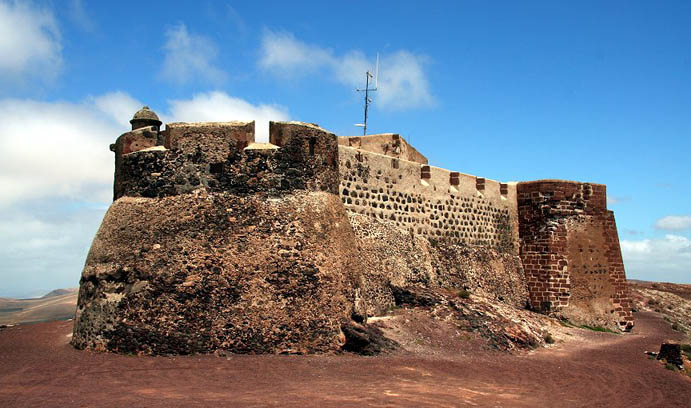Approaching Teguise from anywhere on the island, from a distance one can see a massive stronghold perched on top of the Guanapay volcano.
One kilometer from Teguise, the fortress is the oldest of its kind in Lanzarote: formed in 1551 r. for defense against pirates. Currently, the stronghold is the seat of the modest, but the touching Museo del Emigrante Canario (Emigrant Museum), which presents the history of emigration of the inhabitants of the Canary Islands to South America. From the top of the volcano, there is a wonderful view of the surrounding area.
Nazareth
There is a real Moorish palace in a small town on the outskirts of Teguise, housing the Lagomar restaurant. It is visited by many tourists and inhabitants of the island, not only because of a good kitchen or beautiful interiors, but also for that, to see, how the famous Omar Sharif lived. The house set into the rock was designed by Cesar Manriae, reportedly for the actor. Unfortunately, the owner did not enjoy the house for too long – as rumor has it, he lost cards very quickly.
Famara Cove
A settlement once forgotten by the world, today it is thriving, although still a small tourist destination. Its biggest attraction is a six-kilometer long sandy beach in the shade of a mighty cliff, the longest on the island. Even though it is one of the favorite places of the locals, surfers, windsurfers and paragliders, it is rather not crowded here. It is better to give up sunbathing and swimming, when a strong north wind blows.
There is a Tienda Surf shop-rental in the village, where you can rent the necessary equipment and sign up for surfing lessons, kitesurfing course or rent bikes. The shop owners also rent apartments and bungalows (ok. 8 places) in Apartamentos Famara Suf Apartametny, Bungalows and bungalows can also be rented at Playa Famara Bungalows. There is also a free San Juan campsite in the town-, permission to pitch a tent must be requested at the commune office.
There are several good restaurants in Caleta de Famara, mainly specializing in fresh fish dishes. It is worth trying the excellent food in El Risco, Casa Ramon with nice staff and El Sol, where finding a free table on weekends is almost a miracle.
There is a bus to Caleta de Famara three times a day #20 z Arrecife.
Alone
South of Caleta de Famara, the LZ-401 road leads through desert white sands towards Pico Colorado (Colorful Peak).
The crater, shimmering with various shades of brown and red, can be entered - from above you can see the beach beautifully. The small town of Sóo is located at the foot of the crater, which consists of several dozen traditional white houses.
The Saint
In the vicinity of a small fishing village in front of the sandy La Isleta peninsula, it is huge (400 apartments) Club La Santa resort, to which sport amateurs and professional athletes come to train. You can try your hand at e.g.. in aerobics, cycling, diving, dance, football, swimming, volleyball, tennis, windsurfing and many other disciplines. In addition, the resort has a spa, several restaurants and bars and a disco. Many people decide to come with children, for which a special sports program has been prepared.
White stain
Despite its small size, Mancha Blanca is an extremely important place for the inhabitants of the island – there is an 18th-century chapel and a church built in honor of the island's patron, Virgin of Sorrows, Our Lady of Sorrows, also called Our Lady of Volcanoes (Virgin of the Volcanoes), which saved the city from lava. Apparently in 1736 r. the terrified people of Tinajo walked in a pleading procession toward the advancing lava. The hot stream paused miraculously, in which one of the faithful stuck a metal cross. Witnesses to this event, right next to the cross that is still visible today, they built a small chapel and promised to build a church. It was built only in 1781 r., after the Mother of God appeared to a certain girl several times, insisting, that the people of Tinajo would live up to their promise.
Say hello
Four white houses and a chapel, and the largest and best ethnographic museum in the Canary Islands, Agncola El Patio Museum, it's all Tiagua. The museum is actually a beautifully restored 19th century farm, where you can see folk costumes in traditionally decorated interiors, agricultural tools, loom, as well as a collection of old photos. Parents will be happy to visit the wine cellar operating on the farm, while children will surely be pleased to see farm animals and a camel.
